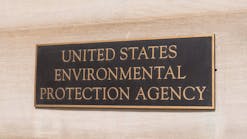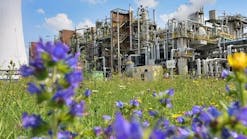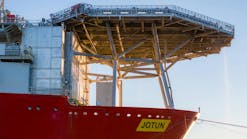Cesar TreviñoA new U.S. Environmental Protection Agency (EPA) rule, effective Feb. 8, 1999, will change the disposal requirements for managing spent hydrotreating and hydrorefining catalysts.
Criterion Catalyst Co. LP
Houston
As the world's largest supplier of hydrotreating catalysts, Criterion Catalyst Co. LP is concerned about regulations that impact catalyst use by its customers. Therefore, Criterion has been closely following the development of this new rule and has prepared this summary which represents its best understanding of how the new rule will impact refiners' spent catalyst management practices.
The impact of the rule can vary depending on individual circumstances, and thus all refiners are urged to study the rule carefully to determine how it applies to their specific operations.
Spent catalyst rule
Under current EPA regulations, a generator of spent hydrotreating and hydrorefining catalysts is not required to classify spent catalysts as hazardous waste unless the catalyst being classified exhibits a hazardous characteristic (for example, benzene concentration exceeding the toxicity characterisitic leaching procedure (TCLP) limit, excessive reactive sulfides, etc.).In 1989, however, the Environmental Defense Fund (EDF) filed a lawsuit alleging that the EPA had failed to meet the statutory mandates under RCRA to determine if certain wastes, including some spent catalysts generated by the petroleum refining industry, should be "listed" hazardous wastes. If the EPA determines that a spent catalyst should be a "listed" hazardous waste, it must be managed as a hazardous waste whether or not the catalyst exhibits any hazardous characteristics.
To settle this lawsuit, the EDF and the EPA entered into a June 1991 consent decree in which the EPA agreed to publish a final listing determination for 14 petroleum refining process wastes. Under the consent decree, the EPA was mandated to finalize a listing determination by Oct. 31, 1996; however, this deadline was extended under numerous agreements until June 29, 1998.
On Nov. 20, 1995, the EPA proposed (59 FR 57747) to list three of the 14 refining wastes as RCRA hazardous, two of which were spent hydrotreating catalysts and spent hydrorefining catalysts. The EPA also requested specific comments regarding whether or not it would be appropriate to list one additional residual, and proposed to not list 10 other petroleum refining wastes.
After an extended period of public comment, the administrator of the EPA signed the final rule on June 29, 1998, and promulgated the rule within the Federal Register (63 FR 42110) on Aug. 6, 1998. The effective date of the new rule will be Feb. 8, 1999.
The final rule adds four new hazardous waste codes to the current list of hazardous wastes, including the following codes for spent hydrotreating and hydrorefining catalysts:
- K171-Spent hydrotreating catalyst from petroleum-refining operations, including guard beds used to desulfurize feeds to other catalytic reactors.
- K172-Spent hydrorefining catalyst from petroleum refining operations, including guard beds used to desulfurize feeds to other catalytic reactors.
Catalyst definitions
Three types of hydroprocessing catalysts were identified in the EDF consent decree. Hydrotreating and hydrorefining catalysts are included within the EPA's listing determination under the final rule. Hydrocracking catalysts were evaluated under a separate study conducted by the EPA, but no action has been proposed to date for spent hydrocracking catalysts.Hydrotreating, hydrorefining, and hydrocracking processes are part of a continuum of catalytic hydroprocessing unit operations. Definitions for the three categories of hydroprocessors are not universally established or accepted. In general, the three processes may be viewed in the following order of increasing degrees of severity of operating conditions and conversion: hydrotreating, hydrorefining, and hydrocracking. The types of catalysts used can be similar in all three processes.
The regulatory language proposed by the EPA in November 1995 did not attempt to define hydrotreating and hydrorefining catalysts or differentiate them from hydrocracking catalysts.
Following review of public comments, the EPA chose to differentiate between hydrocracking units and other hydroprocessing units based on the categorization used in the Petroleum Supply Annual of the Department of Energy (DOE).
Petroleum refineries are required to submit Form EIA-820 annually to DOE's Energy Information Administration. This form includes the mandatory submission of data on operating capacity for catalytic hydro-cracking and catalytic hydrotreating. How the refiner has characterized its hydroprocessing units in its DOE Form EIA-820 submittals determine how its units are classified for purposes of this new rule.
Catalytic hydrotreating is defined in the Petroleum Supply Annual as "a refining process for treating petroleum fractions from atmospheric or vacuum distillation units (e.g., naphthas, middle distillates, reformer feeds, residual fuel oil, and heavy gas oil) and other petroleum (e.g., cat cracked naphtha, coker naphtha, and gas oil) in the presence of catalysts and substantial quantities of hydrogen. Hydrotreating includes desulfurization, removal of substances (e.g., nitrogen compounds) that deactivate catalysts, conversion of olefins to paraffins to reduce gum formation in gasoline, and other processes to upgrade the quality of the fractions."
For the purposes of the new rule, the EPA defined catalytic hydrorefining as a refining process with more severe (higher temperature and pressure) operating conditions than the catalytic hydrotreating process defined above for treating the heavier molecular weight petroleum fractions, residual fuel oil, and heavy gas oil.
Catalytic hydrocracking is defined in the Petroleum Supply Annual as "a refining process that uses hydrogen and catalysts with relatively low temperatures and high pressures for converting middle boiling or residual material to high-octane gasoline, reformer charge stock, jet fuel, and/or high grade fuel oil. The process uses one or more catalysts, depending upon product output, and can handle high sulfur feedstocks without prior desulfurization."
In the rule, the EPA stated that all spent catalyst that was used in guard bed units is subject to the listing determination irrespective of how the refiner classified the unit in DOE Form EIA-820 submissions. Guard bed units are units used to extend the life of the downstream catalytic bed (e.g., reformer, hydrocracker, isomerization reactor, lube finisher) by removing sulfur, oxygen, nitrogen, and/or heavy metals.
New restrictions on land disposal
Historically, about 25% of the spent hydrotreating and hydrorefining catalysts generated by refiners has been buried in landfills.Disposal of spent catalysts in landfills will still be allowed under this new rule. However, the new rule places a significant limitation upon the management of spent catalysts under conditions that constitute land disposal-the Land Disposal Restrictions (LDR) treatment standards.
The statutory provisions mandating LDR require pretreatment of hazardous wastes so that threats to human health and the environment posed by land disposal of the waste are minimized.
All newly listed hazardous wastes must comply with established LDR treatment standards or demonstrate equivalent "no-migration" standards, prior to disposed.
The LDR treatment standards for nonwastewaters that the EPA established for the newly listed spent catalysts are shown in Table 1. The standards established for spent hydrotreating and hydrorefining catalysts are generally equivalent with the RCRA program's current Universal Treatment Standards (UTS). However, the treatment standards established for the inorganic constituents were modified based on comments provided during the EPA's rulemaking.
The EPA anticipates that if landfilled, the majority of spent hydrotreating and hydrorefining catalysts would require treatment to meet the LDR treatment standards. This would increase the cost of landfill as a spent catalyst disposal option.
Mixture and derived-from rules
Perhaps the most significant impact of the EPA's final rule is the application of RCRA "mixture" and "derived-from" considerations for the newly listed spent catalysts. The mixture and derived-from rules provide a simple, yet conservative and strict, method for regulating hazardous waste under RCRA. Mixture and derived-from considerations are most stringent for listed hazardous wastes.The mixture rule states that a mixture containing any portion of a listed hazardous waste (i.e., regardless of the amount of listed hazardous waste contributing to the mixture) is considered a listed hazardous waste and bears the same listing code and regulatory status as the original listed hazardous waste of the mixture.
Similarly, under the derived-from rule, a residual material that is derived from the treatment or management of a listed hazardous waste is also considered a listed hazardous waste and bears the same listing code and regulatory status as the original listed hazardous waste. Under such conditions, materials resulting from being mixed with or derived-from a listed hazardous waste remain hazardous, regardless of treatment, unless they are "delisted" according to procedures defined within RCRA.
Spill/release management
Since conditions that may constitute land disposal (i.e., spillage and/or release) are subject to a wide degree of interpretation, Criterion is concerned that a regulator may take a conservative interpretation that any spillage or release of a spent catalyst during storage or transfer could be considered to constitute land disposal. Under this interpretation, if a release occurs in or reaches an uncontrolled area (i.e., unpaved areas, or areas without containment or curbing), the condition could be interpreted to constitute the land disposal of a listed hazardous waste and a violation of LDR regulations under mixture and "derived-from considerations.To avoid any possible problems from this type of rule interpretation, refiners should review their spent catalyst management practices to assure that adequate precautions are being taken to minimize spillage and releases.
Headworks exclusion
The headworks exclusion is an existing exclusion for certain solid and hazardous waste mixtures contained in wastewater that is subject to regulation under the Clean Water Act (for example, National Pollutant Discharge Elimination System permitted wastewater discharges). During the public comment period associated with this rulemaking, industry requested that the EPA expand the headworks exclusion to include the newly listed spent catalysts.The EPA's final rule expands the headworks exclusion to include qualifying mixtures containing the newly listed spent catalysts. This expansion of the headworks exclusion limits the potential adverse impact of mixture and derived-from considerations for a typical refinery oily water sewer and wastewater treatment system.
Inert support media exclusion
EPA granted a specific exclusion within the new rule for inert support media associated with the newly listed catalysts.The final rule clarifies that the inert support media is not a part of the spent catalyst, and is exempt from the listing. The EPA based its exclusion on the fact that the support media is capable of being screened and/or separated from the spent catalysts and reused or recycled with minimal risk.
The inert support media exclusion minimizes the impact of mixture and derived-from considerations on materials handling and management applications associated with spent catalysts. The exclusion also minimizes the potential impact of the RCRA mixture rule on materials handling and screening of spent catalysts at petroleum refining and third-party regeneration and recycling facilities.
Cercla reporting
The new rule deemed the newly listed wastes to be hazardous substances under the authority of the Comprehensive Environmental Response, Compensation, and Liability Act (Cercla). Under Cercla, the person in charge of a vessel or facility from which a hazardous substance has been released in a quantity that is equal to or exceeds its "reportable quantity" (RQ) must immediately notify the appropriate administrative authority as soon as that person has knowledge of the release.Under Cercla, all hazardous substances have a statutory RQ of 1 lb, unless and until the RQ is adjusted by regulation. The EPA's final rule adjusted the 1 lb statutory RQs for these wastes.
The standard methodology used to adjust the RQs for hazardous waste streams differs from the methodology applied to individual hazardous substances. The procedure for assigning RQs to newly listed hazardous wastes is based on an analysis of the hazardous constituents of the wastes. Based on this procedure, the EPA established an alternative method for adjusting the RQs of the newly listed spent catalysts.
The alternative method involves the option of developing "concentration-weighted" RQs for each of the spent catalysts. Using this alternative method, a generator can determine the maximum observed concentrations of each hazardous constituent in the spent catalyst and use these concentrations to calculate the amount of the spent catalyst necessary to contain the RQ of each constituent.
Under this alternative method, the lowest of the concentration-weighted constituent RQs would become the RQ for the spent catalyst.
The Author
Cesar Treviño has been Criterion's vice-president, sales, since the company's formation in 1988. He is responsible for marketing Criterion's entire product line of nonproprietary catalysts in the Americas, Europe, the Middle East, and Africa. Prior to joining the company, Trevi?o worked for Shell Oil Co. for 25 years in various capacities.He began his career with Shell in 1963 as a technician in its research and development laboratories and assumed several positions, eventually becoming the coordinator for all catalysts used in Shell processes. In 1974, he became involved in catalyst sales, then progressed to product management. Trevi?o holds a BS in chemistry from the University of Texas at Austin.
Copyright 1998 Oil & Gas Journal. All Rights Reserved.



